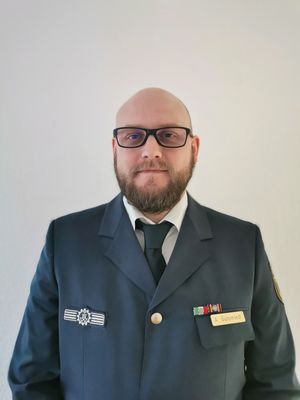KANBrief 1/24

Axel Gutsmiedl, Head of environmental management at the German Federal Agency for Technical Relief (THW), talks about how the THW is dealing with the challenges of climate change, both technically and organizationally.
Climate change is making extreme weather events considerably more likely. Germany is also affected, resulting in rising numbers of THW deployments. Should the trend continue and greater efforts not be made to reverse the human contribution to climate change, floods that previously occurred on average once every 100 years must now be anticipated two, three or four times in the same period. As we witnessed in the Ahr Valley, providing help on the ground calls for enormous resources and capacity. Increasingly often, volunteer emergency crews must provide technical assistance in difficult weather conditions. The burden on personnel rises, and at the same time the willingness to volunteer is reduced. Disasters that occur gradually, such as droughts, also have an impact on the availability of resources. If shipping is suspended due to low water levels, for example, we have difficulties replenishing supplies for our technical equipment after multiple deployments.
I should point out that working in conditions of extreme heat or heavy rain or on cold winter days is nothing new for us. We’re already suitably equipped for such conditions. But the effects also take other forms, for example of a social nature. One specific example is the huge increase in the hours for which we’re deployed. We’re extremely grateful to the regular employers of our emergency personnel for releasing them for service with the THW; this aspect is also governed by the dedicated THW legislation. At the same time, it is of course burdensome for many employers.
The higher number of deployments also result in much higher levels of material wear and tear, and in turn in considerably greater inspection and maintenance overhead for our equipment. This, too, ties up resources, because work following a deployment is also performed by volunteers. Again, these personnel are absent from their regular jobs, or devote their weekends to the THW, to the detriment of family life. The same applies to rest periods: following a major deployment, volunteers return home late, and of course must first observe the rest period.
In the future, we certainly will. A THW project group has been working on the form multifunctional overalls should take in the future. We’re currently at the procurement stage; care has of course been taken to ensure that the overalls can withstand extreme weather conditions. We’ve also carried out various long-term tests and tests in simulated deployment environments at the THW. The new overalls have the advantage of being a modular system, and we’ll be able to integrate smart functions into them in the future, such as sensors for measuring vital data or ambient conditions. At the same time, we need to consider carefully what is actually needed for the assurance of occupational safety and health; the scenarios in which certain equipment is beneficial; and what we can happily manage without, at least for the time being.
What I do know is that when we procure our multifunctional overalls, for example, the temperature ranges that are tested often exceed the requirements in standards. Many manufacturers know that our deployments take place under conditions that are not always comparable with those of other workplaces. They also therefore test at conditions over and above those set out in the standards. In some cases, we also define requirements of our own in the invitations to tender, in order to emphasize certain characteristics or to be prepared for specific situations. The market then aims to respond to these requirements and meet them. In some cases, this also goes beyond the requirements in standards.
Most THW deployments are relatively brief. If I work outdoors for two or three hours, the chance of my equipment overheating is relatively low. But some deployments, like as those in the Ahr valley or during forest fires in the Harz mountains, keep us tied up for several days, possibly in extreme weather conditions. In these cases, we take various protective measures, such as setting up staging areas with mobile air filters with a cooling function, or heaters.